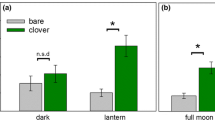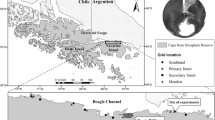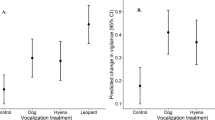Abstract
We used foraging trays to compare how oldfield mice, Peromyscus polionotus, altered foraging in response to the presence of fire ants, Solenopsis invicta, and in the presence of direct (predator urine) and indirect (sheltered or exposed microhabitat, moonlight, and precipitation) indicators of predation risk. Foraging reductions elicited by S. invicta were greater than reductions in response to well-documented indicators of risk (i.e., moonlit nights) and the presence of predator urine. The presence of S. invicta always led to reduced foraging, but the overall impact of S. invicta was dependent upon microhabitat and precipitation. When S. invicta was not present, foraging was greater in sheltered microhabitats compared to exposed microhabitats. S. invicta made sheltered microhabitats equivalent to more risky exposed microhabitats, and this effect was especially pronounced on nights without precipitation. The effect of S. invicta suggests that interactions with S. invicta may entail a potentially heavy cost or that presence of S. invicta may represent a more reliable indicator of imminent competition or predation compared to indirect cues of risk and predator urine. The presence of S. invicta led to reduced foraging under situations when foraging activity would otherwise be greatest (i.e., under vegetative cover), potentially reducing habitat quality for P. polionotus and the distribution of seeds consumed by rodents.

Similar content being viewed by others
References
Abramsky Z, Rosenzweig ML, Subach A (1998) Do gerbils care more about competition or predation? Oikos 83:75–84
Abramsky Z, Rosenzweig ML, Subach A (2001) The costs of interspecific competition in two gerbil species. J Anim Ecol 70:561–567
Blumstein DT (1996) Assessment and decision making in animals: a mechanistic model underlying behavioral flexibility can prevent ambiguity. Oikos 77:569–576
Bouskila A (1995) Interactions between predation risk and competition: a field study of kangaroo rats and snakes. Ecology 76:165–178
Brown JH, Heske EJ (1990) Control of a desert-grassland transition by a keystone rodent guild. Science 250:1705–1707
Brown JS (1988) Patch use as an indicator of habitat preference, predation risk, and competition. Behav Ecol Sociobiol 22:37–47
Cothran EG, Smith MH, Wolff JO, Gentry JB (1991) Mammals of the savannah river site, SRO-NERP-21. Savannah River Site, Aiken, S.C.
Ferris DK, Killion MJ, Ferris KP, Grant WE, Vinson SB (1998) Influence of relative abundance of red imported fire ants (Solenopsis invicta) on small mammal captures. Southwest Nat 43:97–100
Holtcamp WN, Grant WE, Vinson SB (1997) Patch use under predation hazard: effect of the red imported fire ant on deer mouse foraging behavior. Ecology 78:308–317
Holway DA, Lach L, Suarez AV, Tsutsui ND, Case TJ (2002) The causes and consequences of ant invasions. Annu Rev Ecol Syst 33:181–233
Killion MJ, Grant WE (1993) Scale effects in assessing the impact of imported fire ants on small mammals. Southwest Nat 38:393–396
Killion MJ, Grant WE, Vinson SB (1995) Response of Baiomys taylori to changes in density of imported fire ants. J Mamm 76:141–147
Kotler BP, Brown JS, Hasson O (1991) Factors affecting gerbil foraging behavior and rates of owl predation. Ecology 72:2249–2260
Kotler BP, Blaustein L, Brown JS (1992) Predator facilitation: the combined effect of snakes and owls on the foraging behavior of gerbils. Ann Zool Fenn 29:199–206
Lechner KA, Ribble DO (1996) Behavioral interactions between red imported fire ants (Solenopsis invicta) and three rodent species of south Texas. Southwest Nat 41:123–128
Lima SL (1998) Nonlethal effects in the ecology of predator-prey interactions. Bioscience 48:25–34
Littell RC, Stroup WW, Freund RJ (2002) SAS for linear models. SAS Institute, Cary, N.C.
Masser MP, Grant WE (1986) Fire ant-induced trap mortality of small mammals in east-central Texas. Southwest Nat 31:540–542
Morris DW, Davidson DL (2000) Optimally foraging mice match patch use with habitat differences in fitness. Ecology 81:2061–2066
Nolte DL, Mason JR, Eppel G, Aronov E, Campbell DL (1994) Why are predator urines aversive to prey? J Chem Ecol 20:1505–1516
Orrock JL, Danielson BJ, Burns MJ, Levey DJ (2003) Spatial ecology of predator-prey interactions: corridors and patch shape influence seed predation. Ecology 84:2520–2526
Orrock JL, Danielson BJ, Brinkerhoff RJ (2004) Rodent foraging is affected by indirect, but not direct, cues of predation risk. Behav Ecol 15:433–437
Quinn, GP, Keough MJ (2002) Experimental design and data analysis for biologists. Cambridge University Press, Cambridge
Porter SD, Tschinkel WR (1987) Foraging in Solenopsis invicta (Hymenoptera: Formicidae): effects of weather and season. Environ Entomol 16:802–808
Ready CC, Vinson SB (1995) Seed selection by the red imported fire ant (Hymenoptera: Formicidae) in the laboratory. Environ Entomol 24:1422–1431
SAS Institute (2000) SAS user’s guide. Version 8.1. SAS Institute, Cary, N.C.
Schmitz OJ, Beckerman AP, O’Brien KM (1997) Behaviorally mediated trophic cascades: effects of predation risk on food web interactions. Ecology 78:1388–1399
Smith TS, Smith SA, Schmidly DJ (1990) Impact of fire ant (Solenopsis invicta) density on northern pygmy mice (Baiomys taylori). Southwest Nat 35:158–162
Stephens DW, Krebs JR (1986) Foraging theory. Princeton University Press, Princeton, N.J.
Thorson J, Morgan R, Brown J, Norman J (1998) Direct and indirect cues of predatory risk and patch use by fox squirrels and thirteen-lined ground squirrels. Behav Ecol 9:151–157
Vinson SB (1997) Invasion of the red imported fire ant (Hymenoptera: Formicidae): spread, biology, and impact. Am Entomol 43:23–39
Wolfe JL, Summerlin CT (1989) The influence of lunar light on nocturnal activity of the old-field mouse. Anim Behav 37:410–414
Acknowledgements
We appreciate the outstanding field assistance of T. Hunt, D. Kuefler, E. Damschen, E. Koenig, and M. Burns. We are thankful to G. Curler for identifying ant specimens. Logistical support was provided by J. Blake, E. Olson, and other members of the U.S. Forest Service Savannah River. The manuscript benefitted from the comments of D. Coyle, E. Damschen, T. Hinkelman, W. Holtcamp, C. Kwit, and A. Wiewel. Funding and support were provided by the Department of Energy-Savannah River Operations office through the U. S. Forest Service Savannah River under Interagency Agreement DE-AI09-00SR22188. Funding also provided by NSF grant DEB-9907365, a Sigma Xi Grant in Aid of Research to J.L.O., an American Museum of Natural History Theodore Roosevelt Memorial Fund grant to J.L.O., a Professional Advancement Grant and EEB Fellowship to J.L.O. from Iowa State University, and an EPA Science to Achieve Results Fellowship to J.L.O. Ocelot urine was kindly supplied by J. Bush and Big Cat Rescue, Tampa, Fla.
Author information
Authors and Affiliations
Corresponding author
Rights and permissions
About this article
Cite this article
Orrock, J.L., Danielson, B.J. Rodents balancing a variety of risks: invasive fire ants and indirect and direct indicators of predation risk. Oecologia 140, 662–667 (2004). https://doi.org/10.1007/s00442-004-1613-4
Received:
Accepted:
Published:
Issue Date:
DOI: https://doi.org/10.1007/s00442-004-1613-4




